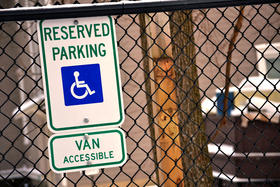Syracuse’s homes are old. Virtually all of them, nearly 95 percent, were built before the Americans with Disabilities Act went into effect a quarter century ago.
That law mandates accessible building standards for people with a disability. But since the ADA was passed, the city’s population has been declining. That means little demand to construct new housing. That’s also resulted in an acute shortage of housing options for people with a physical disability, according to advocates.
"Why isn’t there more housing out there? Because when people get the units, they tend to stay," said Robin Hopkins, the housing advocate for ARISE, a nonprofit working with disabled people.
And that lack of turnover among the few units out there has created a backlog. There are over a hundred families on Hopkin's waiting list.
"So when they go to look for, for example accessible wheelchair unit, they’re placed on a waiting list and it could take up to four years for that person to come to the top of the list to be offered a unit," she said.
Hopkins spends much of her days searching apartment listings and contacting landlords. With so many requirements from families, like number of bedrooms, a match is hard to make.
"Exacerbated" by poverty
In Syracuse, 8.2 percent of the population has a physical disability, according to Census data. And of the disabled, nearly four in 10 are poor. City officials say their housing needs are “exacerbated” by a lack of affordable housing. Only five percent of the city’s publicly subsidized housing is fully accessible.
Poverty obviously makes building a new home out of the question for many. And modifying an existing home is the less than ideal way to make a home livable for a wheelchair, advocates say. Retrofits like ramps and roll-in showers are expensive, though grants do exist.
It’s meant few options for people in need of better living conditions. Some of the few new apartments in Syracuse fit for wheelchairs is opening this month. Christopher Community Homes built the affordable housing complex on South Salina Street.
All the doorways are at least 36 inches, bathrooms are larger, light switches are lower, explains the president of the nonprofit, Doug Reicher, on a tour.
There are 37 units in the complex, but only the ones on the first floor can accommodate wheelchairs. Christopher Community Homes received several hundred inquiries from potential tenants, Reicher said, a further sign there isn’t enough affordable or accessible housing on the market.
Reicher concedes a major construction boom would be needed in order to catch up.
"I would guess if we had to do that, we would probably have to triple out output, all of us together doing housing, would really have to triple our output," he said.
A tough find
Until that happens, the hard and demoralizing search continues for many.CNY Fair Housing is compiling a report on finding rental properties suitable for someone with a disability.
"We actually went through 1,000 rental listings in order to come with 30, about 30 properties to test," said executive director Sally Santangelo.
 Many complaints to fair housing hotlines have to do with accessible parking.
Many complaints to fair housing hotlines have to do with accessible parking.
Credit Ryan Delaney / WRVO
And that’s just apartments that would be suitable for a disability, not necessarily accepting. Charges of discrimination by landlords unwilling to accommodate wheelchairs are common, thoughlaw requires them to. About 60 percent of complaints to CNY Fair Housing's hotline have to do with accessibility, according to Santangelo.
"That kind of mirrors what somebody with a mobility impairment is going to face when they’re trying to find housing," she said.
The extreme lack of accessible housing stock has forced many families to be separated, with disabled members often having to move into senior housing. That isn’t an environment ideal for younger people or disabled people with children.
So why not build a massive housing development of just accessible housing units? That would only perpetuate segregation, Santangelo said. And there’s also just not the funding to build more.
"I think as a community, we can’t expect anybody to come in with millions and millions of dollars to solve our problems. I think we need to find small ways to start work at these things," she said.
City law requires all new homes built to meet basic accessibility standards, but that’s theoretical while demand for new houses remains sluggish.



